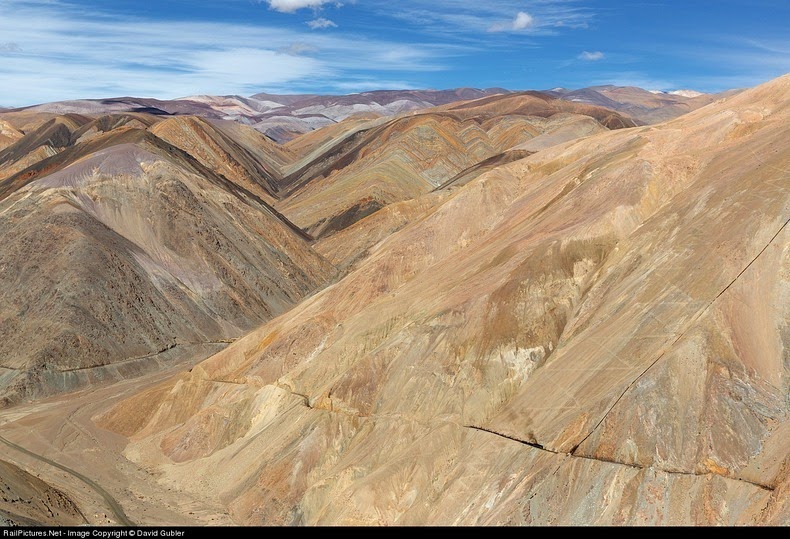The Chanaral – Llanta – Potrerillos line in Chile is one of the most stunning railways in the world. It connects Potrerillos, a now abandoned town and mine in the remote Andes located 2850 meters above sea level, with the filtration plant and workshops in Llanta and Diego de Almagro, where the line connects to the Longitudinal Norte, and continues to Chañaral and the harbor at Barquito. The line was built starting 1916 by the Andes Copper Mining Company to connect the Potrerillos copper mine and smelter with Pueblo Hundido (now called Diego de Almagro), where it connected to the state railway network, which continued to Chañaral.
The Potrerillos mine started production a decade later in 1927. The railway was subsequently used to transport supplies to Potrerillos and refined copper to the harbor at Barquito. Although the deposits of Potrerillos were smaller and its ores of poorer quality than those at Chile’s principal copper mine at Chuquicamata, the mine made an important contribution to the country’s copper production. The diminishing quality of its ore and the discovery of another substantial body of copper ore in 1954 at nearby Indio Muerto, finally lead to the closure of Potrerillos mines in 1959. The company town that had been established at Potrerillos was abandoned by the end of the 20th century, but a copper smelter and refinery continued to operate at the location.
In 1959, the mines at Potrerillos were replaced by those at El Salvador. Since then, the liquefied ore is transported by pipeline from El Salvador to a filtration plant near Llanta, from where the dried ore concentrate is transported by railway to the Potrerillos plant. Potrerillos now supplies other plants with sulfuric acid, required for purification of copper, both by truck and railway.
The line between Potrerillos to Barquito is 155 km long, and between the mines to the filtration plant in Llanta is 90 km in length. The most spectacular section is the ascent between the station Montandon (2350 m) and Potrerillos (2850 m), where it passes through closed curves and tunnels, always beaten to the slope. On the last 66 km between Llanta and Potrerillos, the railroad first passes a rugged, lonesome valley and finally winds up to the terminus of the line, passing a breathtaking mountain scenery.

Can you spot the train in this picture? Photo credit
A train climbing towards Potrerillos. Photo credit
A train loaded with copper concentrate from Llanta, near Montandon - Potrerillos in metric gauge line, with a maximum slope of 3.9% in this section.A beautiful condor accompanying the passage of the train, from the heights of Andes mountain. Photo credit
A train loaded with 23 tank cars full of sulfuric acid, leaves the Potrerillos copper plant. Photo credit
A train loaded with sulphuric acid accelerating out of Montandon, at the foot of the 3.9% grade. Photo credit
From the colorful heights of Andes mountain, two EMD GR12 and FERRONOR copper train already soon get to Potrerillos foundry, and with its characteristic and complete black color seems a tattoo on the wall of the mountain. Photo credit
Sources: Wikipedia / Myetymology / Britannica / Markus' Classic Trains

































Wow, amazing pictures! Thanks for the article!
ReplyDeleteChañaral is nowadays the home of a huge artificial white beach. Usually, this is good news for tourism, except that this particular beach was created with the wasts of the copper mines.
It has since become the population's curse. OCEAN71 Magazine wrote an article on the subject: http://ocean71.com/economy/chanaral-chile-pollution-copper-metal-mine-beach-pacific/
Spread the information so that it will never happen again some place else!
Thanks, and take care.
Andy
Awesome photos - interesting writeup. What other kinds of minerals are they extracting? I visited in 2007.
ReplyDelete